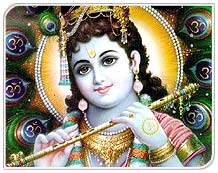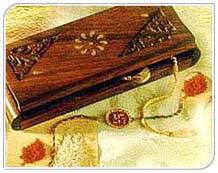Cultural India
Cultural India Home » People » History » National Anthem » National Animal » National Tree » Fairs & Festivals
Physical Features » National Emblems » National Bird » National Fruit » Religions » Languages
National Flag » National Flower » Air Line Ticketing » Map of India » Travellers Tools
---------------------------------------------------------------------------------------------------------------------------------------------------------------------------------------------------------------------------------
Fairs & Festivals
September | October | November | December
August Fairs & Festivals
 JANMASHTAMI
JANMASHTAMI(All over India)
The birth anniversary of Lord Krishna, the incarnation of Vishnu is observed
all over India. It is celebrated with great fervour at Mathhura and Brindavan
where Lord Krishna spent his childhood. Night long prayers are offered and
religious hymns are sung in temples. Scenes are enacted from Lord Krishna's
life. In Maharashtra, earthen pots of curd and butter are hung high up over
the streets. Young men enacting an episode from Krishna's childhood form human
pyramids by climbing on each others shoulders and try to break these pots.
ONAM
(Kerala)
Onam is Kerala's most popular festival, celebrated with great enthusiasm.
It is primarily a harvest festival celebrated to welcome the spirit of the
pious King Mahabali from eternal exile and to assure him that his people are
happy and wish him well. At trichur, caparisoned, elephants take part in a
spectacular procession. There is also a maginificent display of fireworks.
At Shoranur, appreciative crowds gather on the green where colourfully dressed
Kathakali dancers re-enact the well-loved stories of the epic heroes and virtuous
women. On the second day of the festival, every home is lit bright and decorated
in preparation for the visit of King Mahabali. Greetings are exchanged and
lengths of auspicious saffron cloth are presented by friends to one another.
The Vallumkali (boat race) is one of the main attractions of Onam, and is
best seen at Aranmulai and Kottayam. About a hundred oarsmen row huge and
graceful odee (boats). Oars dip and flash to the rhythum of drums and cymbals
in each boat. The songs are generally topical in character and concern people
well known in Malabar. Above each boat gleam scarlet silk umbrellas, their
number denotes the affluence of the family owning the boat. Gold coins and
tassels hang from the umbrellas.
NAAG PANCHAMI
(West Bangal, Maharashtra and South India)
Nag Panchami is the festival when snakes, the symbols of energy and prosperity
are worshipped. In Maharashtra, snake charmers go from house to house with
dormant cobras ensconced in cane baskets, asking for alms and clothing. Women
offer milk and cooked rice to the snakes and gather around to see the snakes
spread their hoods to the tune of the pungi. Clay snakes are brought home
to be worshipped by day and immersed in the sea in the evening. In southern
India, particularly in Kerala, snake temples are crowded on this day and worship
is offered to stone or metal icons of the cosmic serpent Ananta or Shesha.
 RAKSHABANDHAN
RAKSHABANDHAN
(North India)
This is Hindu sister's day when brothers and sisters reaffirm their bonds
of affections. Sisters tie colourful threads or rakhis on their brothers'
wrists. The brothers in turn promise to protect their sisters and give them
gifts.
GANESH CHATURTHI
(Maharasthra, Tamil Nadu, Andhra Pradesh, Karnataka)
Ganesha Chaturthi is an important festival in India, especially in Maharashtra
dedicated to Lord Ganesha, the elephant headed God to all good beginnings
and success. It is believed that Lord Ganesha was born on this day and every
chaturthi is considered auspicious. Thousands of clay idols of Lord Ganesha
are made in every size, pose, form and colour and worshipped at community
or family festivals which last between one to ten days. These images are
then taken in large processions, amidst the rhythm of bells and drums and
immersed in flowing water.
Physical Features » National Emblems » National Bird » National Fruit » Religions » Languages
National Flag » National Flower » Air Line Ticketing » Map of India » Travellers Tools